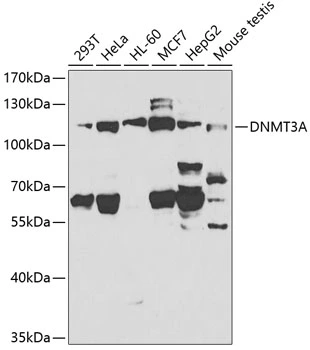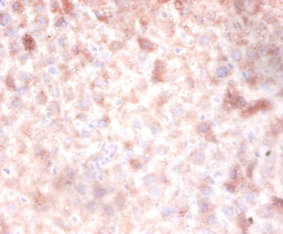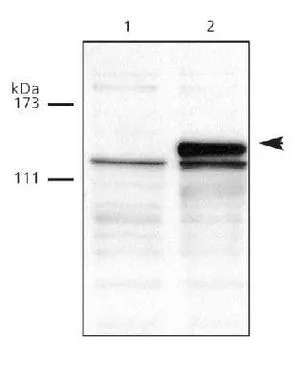
IP analysis of 293T cell lysate using GTX55596 DNMT3A antibody. Antibody amount : 3microg / 200microg lysate Dilution : 1:1000
DNMT3A antibody
GTX55596
ApplicationsImmunoFluorescence, ImmunoPrecipitation, Western Blot, ImmunoCytoChemistry
Product group Antibodies
TargetDNMT3A
Overview
- SupplierGeneTex
- Product NameDNMT3A antibody
- Delivery Days Customer9
- Application Supplier NoteWB: 1:500 - 1:2000. ICC/IF: 1:20 - 1:100. IP: 1:50 - 1:200. *Optimal dilutions/concentrations should be determined by the researcher.Not tested in other applications.
- ApplicationsImmunoFluorescence, ImmunoPrecipitation, Western Blot, ImmunoCytoChemistry
- CertificationResearch Use Only
- ClonalityPolyclonal
- ConjugateUnconjugated
- Gene ID1788
- Target nameDNMT3A
- Target descriptionDNA methyltransferase 3 alpha
- Target synonymsDNMT3A2, HESJAS, M.HsaIIIA, TBRS, DNA (cytosine-5)-methyltransferase 3A, DNA (cytosine-5-)-methyltransferase 3 alpha, DNA MTase HsaIIIA, DNA cytosine methyltransferase 3A2, cysteine methyltransferase DNMT3A
- HostRabbit
- IsotypeIgG
- Protein IDQ9Y6K1
- Protein NameDNA (cytosine-5)-methyltransferase 3A
- Scientific DescriptionCpG methylation is an epigenetic modification that is important for embryonic development, imprinting, and X-chromosome inactivation. Studies in mice have demonstrated that DNA methylation is required for mammalian development. This gene encodes a DNA methyltransferase that is thought to function in de novo methylation, rather than maintenance methylation. The protein localizes to the cytoplasm and nucleus and its expression is developmentally regulated. [provided by RefSeq, Mar 2016]
- Storage Instruction-20°C or -80°C,2°C to 8°C
- UNSPSC12352203




![IHC-P analysis of human placenta tissue using GTX18052 DNMT3A antibody [PCRP-DNMT3A-1E2].](https://www.genetex.com/upload/website/prouct_img/normal/GTX18052/GTX18052_20200115_IHC-P_964_w_23060620_176.webp)



